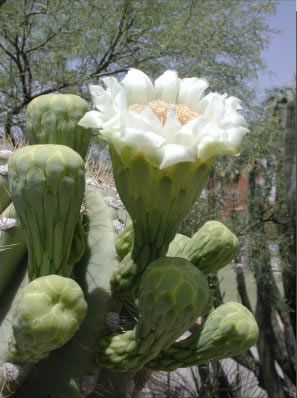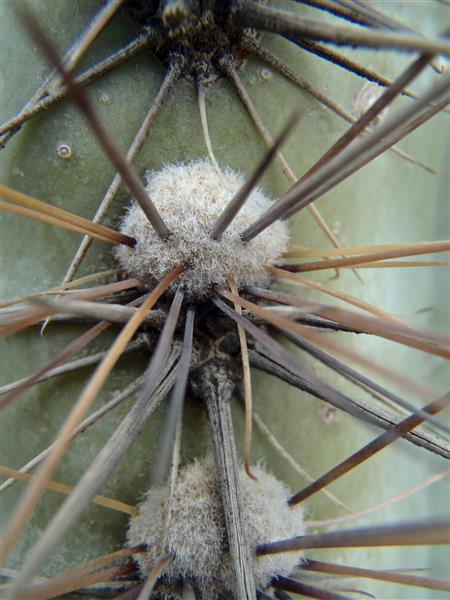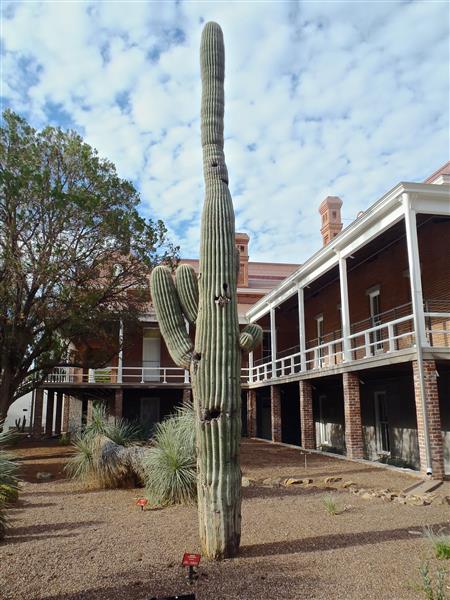

 Family: Cactaceae
Family: Cactaceae
Common Names:
- English: saguaro
- O'odham: ha:san
- Yeome: sauwo
Scientific Name: Carnegiea gigantea
Rain Garden Zone: C.gigantea thrives in the top rain garden zone.

Reproduced with permission from "Rainwater Harvesting for Drylands and Beyond" by Brad Lancaster, HarvestingRainwater.com
Flowering Season: Foresummer
Characteristics: C. gigantea is a large, columnar cactus which may sprout arms at a middle age of about 75 years (1). The cactus grows up to 50 ft tall and is capable of surviving up to 200 years (1). Areoles are arranged in vertical rows, from which straight needles protrude (1). Flowers are large and white in color, and produce green, oval shaped fruit with red flesh (1).
Landscape Cultivation: The cactus is low water use and semi - frost hardy (down to 21 oF); it is commonly found in warm areas and gravelly slopes (2). Young saguaros grow well under the protective canopy of a nurse plant (mesquite, paloverde, acacia, creosote, hackberry, etc.) (1). Low nitrogen may limit growth of the cactus, so it may benefit from being planted near a nitrogen-fixing partner (3).
Ethnobotany:
Wildlife:
Many animals feed on the fruit, including doves, cactus wren, javalinas, and coyotes (1). Birds such as the Gila woodpecker, owls, and Harris hawks find nesting in or on the saguaro (1). Flowers attract Lesser long nosed bat and Mexican Long Tongued bat (4).
Food:
Once a major staple food of the Gila Pima; pulp and seeds can be eaten raw, dried, or cooked (5). The fruit has a wide variety of culinary uses, from being made into jellies (6), to being used as an ingredient in atole (a Mexican drink thickened with corn flour) (7).
Other:
The saguaro’s skeleton has versatile uses as a building material (2), and the saguaro’s seeds may be used for leather tanning (8).
References:
- UA Campus Arboretum
- Arizona-Sonora Desert Museum
- Turner, Raymond M., Bowers, Janice E., and Burgess, Tony L.. (1995) Sonoran Desert Plants - An Ecological Atlas. University of Arizona Press.
- Ingram, Mrill; Buchmann, Steve; Nabhan, Gary. (1998) Gardening for Pollinators. Arizona-Sonora Desert Museum.
- Rea, Amadeo M.. (1997) At the Desert’s Green Edge: An Ethnobotany of the Gila River Pima. University of Arizona Press.
- Niethammer, Carolyn J. (1987). The Tumbleweed Gourmet – Cooking with Wild Southwestern Plants. University of Arizona Press.
- Facciola, Stephen. (1998). Cornucopia II - A Source Book of Edible Plants. Kampong Publications.
- Edholm, Steven and Tamara Wilder. (1997) Wet-Scrape Braintanned Buckskin. Paleotechnics.
To learn more about this species, see the Campus Arboretum species description page.

